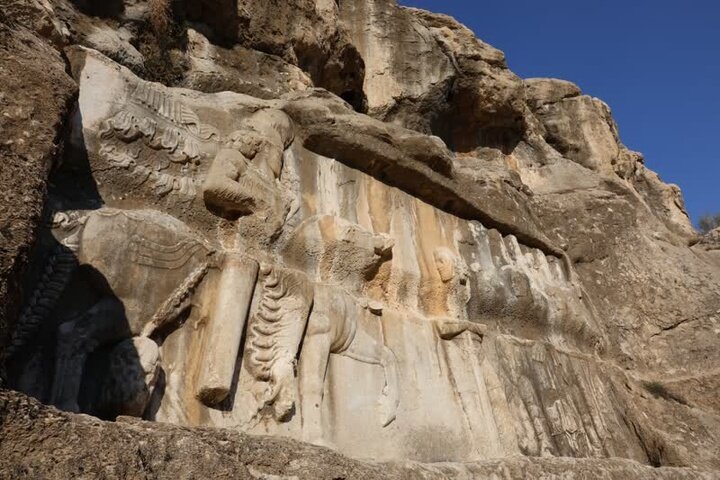Emergency restoration of Sasanian rock relief depicting King Bahram II completed

TEHRAN - The emergency restoration of a Sasanian rock relief of Bahram II at Tang-e Chogan, located in Bishapur, Kazerun, Fars province, has been completed, the provincial tourism chief said on Saturday.
Mohammad Sabet-Eqlidi stated that following the collapse of a section of the relief known as the “Pashe Paran” which is a kind of fly swatter, a team of stone restoration experts was dispatched to Kazerun. “And documentation and restoration efforts began promptly.”
Eqlidi explained that the damaged part of the relief, which had been mistakenly referred to as a mace in media reports, was originally destroyed in 2011 by an individual seeking treasure. The relief was fragmented into numerous small and large pieces.
“Initial restoration efforts were conducted by specialists from Persepolis stone restoration at that time. However, due to natural factors, the section collapsed again and required further restoration.”
During the recent restoration project, modern conservation techniques and new materials were used to clean, reassemble, and restore the relief, the official noted.
The bas-relief is flanked by several others of its kind which are considered among the most valuable carvings from the Sassanid era, depicting significant scenes such as the victories of Iranian monarchs over Roman emperors. The site contains six reliefs, with two on the right side of the entrance and four on the left. Three of these reliefs illustrate the victory of Shapur I over a Roman emperor.
Eqlidi further stated that other reliefs at the site depict the triumphs of Sassanian kings over rebels and enemies, as well as symbolic scenes such as the bestowal of the divine ring of power by Ahura Mazda and the subjugation of Ahriman under a galloping horse.
The newly restored relief shows how the king receives a delegation of Arabs. This relief is very interesting because it is the only Sasanian monument that shows an embassy. The envoys are brought to the king by a Persian nobleman with a long sword.
Bahram II, the fifth Sasanian King of Iran, was the son and successor of Bahram I (r. 271–274). The Sassanid era is of very high importance in the history of Iran. Under Sassanids, Persian art and architecture experienced a general renaissance. Architecture often took grandiose proportions such as palaces at Ctesiphon, Firuzabad, and Sarvestan which are amongst the highlights of the ensemble.
In 2018, an ensemble of Sassanian historical cities in southern Iran, titled “Sassanid Archaeological Landscape of Fars Region”, was named a UNESCO site. The ensemble comprises eight archaeological sites situated in three geographical parts of Firuzabad, Bishapur, and Sarvestan. The World Heritage site reflects the optimized utilization of natural topography and bears witness to the influence of Achaemenid and Parthian cultural traditions and Roman art, which later had a significant impact on the architecture and artistic styles of the Islamic era.
AM
Leave a Comment